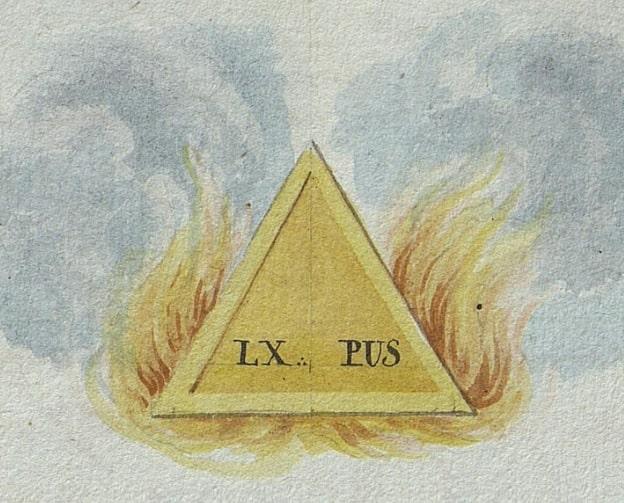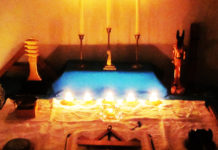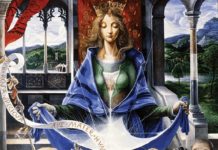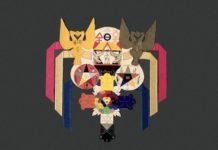At Pansophers all the main authors are fans of the Egyptian Rite of Memphis Misraim, Cagliostro and the Rite of Misraim itself. That’s why we were enthralled to learn Mathieu Ravignat was writing a book covering the original Hermetic and alchemical degrees of the Rite of Misraim and reviving some of its rare masonic degrees. Our earlier Rosicrucian Review of the Egyptian Rite of Memphis Misraim has become a widely discussed post. However, other than Milko’s books, very little information for those outside the Egyptian Rite has ever been available to clarify this broad topic, especially in the English speaking world. That’s why I was excited to learn that at last Ravignat’s book is here and we can now all learn about Egyptian masonry and its alchemical and hermetic mysticism.
I put eight questions to Mathieu Ravignat to find out more:

You admit in your book that you have modified the high degrees of Traditional Egyptian Freemasonry so that they can actually be practiced? Can you explain your method, and tell us why you just didn’t translate them verbatim as a resource for the world?
Firstly, I should say my book does not cover the original Misraïm Apprentice, Companion, and Master degrees as they are quite similar to most Blue Lodge degrees out there. They can be found in the Gaborria Archives but also in Serge Caillet books on Memphis and Misraïm (M+M). I wanted to focus on what is truly unique in Egyptian Freemasonry, which is its Alchemical and Theurgical based High Degrees
My passion is to give new breath to old degrees and their spiritual practices so that they can come alive again. I find this spiritually and even historically useful for the Esoteric community.
As in my book on the Élus Coëns, I have limited myself in it to the historical phenomenon at hand, to the actual internal evidence found in the degrees and writings of the founders. I try to let the founders speak for themselves. My additions mainly include brief commands and ritual mechanics which are assumed in the degree manuscripts already but not explicitly spelled out. When I reconstruct a lecture that was mentioned, but not included, I do so mainly on the basis of the original Catechism of the degree. Fortunately, many Masonic ritual manuscripts tend to repeat themselves!
The original high degrees of Egyptian Freemasonry, including the original Misraïm degrees, as strict verbatim translations, cannot be worked practically. Therefore, I could call my versions of these high degrees “reconstructions” but while doing so, we have to bear in mind, that all M+M groups today operate high degree rituals which are also reconstructions, or rather expansions of incomplete ritual notes. This is especially true for the final Arcana Arcanorum degree rituals (87th to 90th degrees) which were reconstructed in the 1930’s.
When reconstructing an old ritual I honestly try really hard not to mistakenly modify the spiritual meaning of the degrees. I also try not to make any leaps of logic or compare with or insert material from other traditions while doing so, unless I know that they used a particular resource. Those rare times that I do, I make an effort to be very transparent about it. It is not that I don’t find comparisons interesting just that I think one must have a very historically accurate understanding of a Tradition before one can compare it to others.
In the 20th and 21st centuries, under the influence of Blavatsky and the New Age mainly, Esotericism has become very eclectic and though that might be a good thing, one cannot project that in the past when trying to understand a phenomenon.
So, in other words, when I reconstruct a degree or practice, I try and be as faithful to the source material and the times as possible and to approximate what would have likely been known and done at that time.
In your book you say that Egyptian Masonry is dead, and yet one could say that there are more Egyptian Grand Lodges than ever. What do you mean?
I admit that was an intentional provocative statement! As a researcher I find debate healthy, and necessary even in Esoteric circles. I mean how can we progress all together if we do not have healthy discussions based on historical facts and challenge each other?
What I meant is simply that Egyptian Masonry, as it was practiced in the 17th and 18th centuries, by figures such as Tschoudy, Cagliostro and Bédarride died out. You would think that the Rite of Misraïm would have survived through the M+M, but the reality is that almost all the degrees the M+M work are versions of the Scottish Rite degrees and those degrees that are not, are mainly late 19th century creations by Yarker and even those are mostly incomplete. I have a lot of respect for Yarker, he was a very dedicated Mason and had a great syncretic mind, but his degrees are not original to Misraïm or to Egyptian Freemasonry in general. We can know all this now because those rituals are available to us in their more complete versions and not just in Summary-Tyler form, for example in the Gaborria and Kloss Archives.
When one takes a real careful look at what Marconis de Nègre actually did in establishing his M+M Rite, it is clear that his combination Rite was more a takeover of Traditional Egyptian Masonry and the Rite of Misraïm than a continuation of it. Fast forward to today, the Rite of M+M now represents the syncretic obsession of the late 19th and 20th centuries and attempts to cover a vast amount of cultural ground, including, for example, Hindu and even Norse material. There is of course absolutely nothing wrong with that, but that was not the intent of Traditional Egyptian Freemasonry.
The current status quo is that the original Egyptian and Misraïm degrees are simply not practiced by the vast majority of jurisdictions today, apart from the recently reconstructed short AA degrees. I am not the first to say this. Most serious French Masonic researchers like Roger Dachez, Serge Cailet have come to the same conclusion.
Therefore, what this book brings, for the first time, to practitioners and groups today, is an accessible and practical working system to operate the Traditional Egyptian Masonic degrees and their spiritual practices. At least as far as can be done using the original source material.
What exactly is Egyptian Masonry?
Egyptian Freemasons today will be surprised to discover that it is a lot narrower in definition than they might think. In my book, I carefully analyze the original degrees and writings of the founders to find the underlying definition they were using. Through this careful reading, I, and other researchers in France, have concluded that Egyptian Freemasonry originally consisted of five main things:
- Interest in the Ancient Pagan Mysteries, including the Egyptians;
- references to Adam and the Genesis story for the ultimate origin of the Rite;
- the teaching of Alchemy which is said to be Egyptian in origin;
- the teaching of Astrology and particularly the influences of the Seven Planets; and
- the teaching of the Kabbalah, including its angelic hierarchies and Theurgy
In many ways, Traditional Egyptian Freemasonry could actually be called “Adamic Masonry” in the sense that Adam and repairing his fall is a very important reference for the whole tradition.
Tschoudy, Cagliostro and Marc Bédarride all exemplify these criteria. It is also interesting to note that all of them had strong ties to Naples and early Italian Freemasonry which I argue in our book is not an accident.
What would you say was your most interesting discoveries while writing the book?
I would say that it is the continuity in teachings and coherence between Tschoudy, Cagliostro and Bédarride. It became clear to me that I was dealing with teachings which were connected over time. This may seem obvious to most, but it was only a working hypothesis for me. But it is clear that Tschoudy, Cagliostro and Bédarride have very similar approaches towards Alchemy for example and even Theurgy and Bédarride made the Hermetic core of his Rite the Tschoudy High Degrees. Also, once I lined up all my translations, I was surprised at how related, systematic, coherent, and progressive all of it was.
I would also say that the contents of the Knight of the Argonauts and Knight of the Golden Fleece were a fascinating discovery too. These are minimally Masonic but allegorically very deep from an Alchemical perspective despite being almost exclusively Pagan in content.
Another interesting discovery was when I carefully compared what I had with the degrees and teachings of the Strict Observance Rite (SOT) and the Gold und Rosencreunz Orden (GuRC). I was expecting to find similarities yet instead was surprised to find that they were completely different. The SOT degrees are not very alchemical at all and the teachings in the GuRC are clearly from a different alchemical tradition.
How would you compare today’s Egyptian Masonic lodges to the original intention?
I would say that to the extent that they wish to initiate people into Freemasonry while offering them a spiritual practice which is hermetic based, they are in the spirit of traditional Egyptian Freemasonry. Traditional Egyptian Freemasonry was spiritually a lot more operative than most Masonic Rites today which are more moral and social in nature. So, the intent is the same though the content and means are very different. As I have said before, Egyptian Freemasonry was extremely Alchemical and Theurgical. In its Alchemy and Theurgy it reflects the practices as they were taught in the 18th century, so this is pre-Eliphas Lévi, pre-Blavatsky, pre-Albert Pike and Pre-Steiner. Therefore, the influences of those authors and their concepts are just not present. It is also before the impact on our culture from Eastern spiritualities, like Hinduism, Buddhism and Taoism.
I would also say the core of Traditional Egyptian Freemasonry is less Scottish Rite like than most M+M Grand Sanctuaries practice today. A little bit like what Pasqually did, it is clear that the Founders were modifying existing Écossais Masonic degrees to teach an Alchemical and Theurgical doctrine of spiritual and physical regeneration. They were trying to undo the Fall of Man by restoring him to his original dignity and power. Unlike Pasqually, however, the methods were more typical of what we can find during that period, for example, in Paracelsus or the Heptameron, etc., unlike Pasqually’s rather idiosyncratic system. The genealogy of important Alchemical teachers for example, include all the regular suspects (such as Raymond Llull, Paracelsus, Nicolas Flamel, etc.) and the decorations and furniture of the Chapter in the very Theurgical Black-Eagle Rose-Croix degree is actually a physical reproduction of the Grand pentacle of Solomon found in the Heptameron.
Most M.M lodges have an Arcana Arcanorum or Internal Alchemy system. How relevant are these to the original Egyptian masonic system”?
My research has found at least six distinct things being called the AA in the M+M community today (and there may be more!): 1) the original high degrees of the Egyptian Rite of Misraïm in Tyler form; 2) the modern Belgian reconstructions and commentaries or “oral teachings” on them; 3) Cagliostro’s spiritual practices with added material from other sources to fill in the gaps; 4) Lebano’s Theurgical practices mainly derived from Eliphas Levi; 5) internal Alchemy practices mostly drawn from Kremmerzian sources; 6) and a syncretic Kremmerzian-Eastern Taoist and Buddhist internal Alchemy system promoted by Guidicelli.
The truth of the matter is that the original AA manuscripts are nothing but the degree summaries of the 87,88,89, 90th degrees. For Bédarride these were mainly administrative, basically related to duties of the Grand Council General and its Officers, but for Joly they were supposed to contain the whole of the philosophy of Masonry. But really all we have is a few passwords and summary phrases for these.
It was the Belgian Memphis+Misraim Brothers affiliated with Bricaud and Chevillon which fleshed out these bare bones AA manuscript notes into fully fleshed and operative rituals and this only in the 1930s. The AA degrees that followed were influenced by those reconstructions.
As for Inner Alchemy, it depends on how you define this. In my book, I define it as the Alchemical transformation of the human organism, which is different than the transformation of something exterior like metals or plants, such as when making a metallic stone or a tincture or elixir. In Inner Alchemy the goal is to transform one’s self, physically, ethically, and spiritually. In that sense there is an Inner Alchemy in Traditional Egyptian Freemasonry but we don’t have to borrow its definition from the East and it is typically Western. Some Taoist and Hindu practices using the reproductive system to cause regeneration and immortality have seeped into some M+M Grand Lodges. But the fact is that in Cagliostro’s quarantaines (retreat of 40 days) there is no evidence of sexual teachings (apart from absolute chastity) and nor are there any sexual Alchemical teachings in Tschoudy’s writings or Bédarride’s.
However, what you do find, is the use of the digestion system and this typical of the Western Inner Alchemical method in my opinion. This really shouldn’t come to a surprise for those familiar with Paracelsus’ methods. In Tschoudy and Cagliostro the practitioner must ingest certain things in order to operate his own regeneration. The digestive system is seen as the human Athanor. For Tschoudy this is done through the consumption of certain foods on a “Celestial Table” associated with the Sun’s progression through its different Houses, whereas Cagliostro emphasizes more the taking of certain powerful substances such as a form of Prima Materia and Elixirs so as to cause the body to change in a rather violent way. The consumption of these things is not totally absent from Tschoudy either.
Therefore, to the extent that modern M+M Grand Lodges have tried to reproduce the quarantaines of Cagliostro they are consistent with what was done in the original Tradition. By the way, I offer a safer reconstruction of this in my book. Also, if they are trying to practice 18th century Theurgy they could be historically on the right path as well, however from what I can tell most don’t. The Theurgy that is practiced is based on Lebano who in turn based much of his writings on those of Eliphas Lévi and is therefore form the late 19th century. The Invocations of the 4 and 7 Powers practice is such an example.
I noticed that you included new full-length AA rituals in your book. How could you do that if there was so few details about these degrees originally?
As several people told us that the Belgian reconstructions of these and others out there were disappointing, they encouraged us to have a go at composing some of our own. So I did, but same time we included verbatim translation of the original degree summaries in the appendices of the book.
I composed these versions based on my knowledge of the nature of Traditional Egyptian Freemasonry as a whole and on the meaning of the Sacred Names used in the original AA Degree summaries. The degrees I composed are a mix of Pagan and Judeo-Christian elements because at that time Hermeticism was still conceived in that way and it would have been anachronistic and disingenuous of us not reflect this in our AA degrees as well. I therefore decided to present a mix of Alchemical and Kabbalistic teachings which were hinted at in the different degrees but not explicitly taught in them. In a way trying to fill in the gap of the other teachings which they never seemed to have gotten to.
Three of the four degrees have Judeo-Christian and even Christian-Gnostic names including: Zao, Jehovah, Uriel, Sophia, whereas the last Degree also refers to the Egyptian gods: Osiris and Isis. In addition to these names there are also some hints, albeit scant, about the nature of the original mysteries of the degrees.
The 87th Degree for example has Alchemical colours associated to its apartments, black, green, red, and white. Also, one of its Sacred Phrases, “I am,” is quite revealing indeed. Therefore, our 87th degree is a kind of transitional Degree from interpreting Alchemy as an external practice to one which is more internal.
Whereas, for the 88th Degree, given that the Sacred Name is Jehovah and there is a hint given that it is supposed to be about the relationship between man and Divinity, I decided to reconstruct it around more advanced teachings on the Microcosmic and Macrocosmic relationship and on the Divine Hierarchies found in the Kabbalah.
For the 89th degree, given that Zao can refer to Gnostic concepts around Nature, and it is said in it that Zao is: “the name of Nature that all the ancient peoples adored, as a symbol of Divinity.” I have reconstructed my Degree based on the seed of the Divine Spark and the Power of Life within all creation.
As for the 90th Degree, given its very clear reference to Isis and Osiris, I have created an Egyptian-themed Degree with particular reference to the myth of the judgment hall and Isis reconstituting the body of Osiris.
But in order to maintain historical accuracy, I have also referred to Adam Kadmon in all of this. Given that traditional Egyptian Freemasonry can really be understood as Adamic Freemasonry, making reference to the Kabbalistic mysteries of Adam seemed to be essential in the highest degrees of the entire system.
I noticed that you added some additional related material in your book, can you comment on these?
Sure, given all the mystery surrounding the consecration degree of the 66th I decided to include a verbatim translation of the original 62nd High Priest Sacrificer degree from the original Rite of Misraïm. The 66th degree as it is practiced today is a modern Jean Bricaud composition with some Vedic references (Bricaud was very fond of the Vedas). So in a way it is neither a Memphis or Misraïm degree. Therefore, I found it interesting to give everyone access to the original Misraïm degree for comparison’s sake. It is not an exaggeration to say that they are very different.
I have also included a verbatim translation of the original Misraïm 77th degree which at one time was the highest degree in the Rite of Misraïm. It is interesting to read this in light of the later creations of the higher degrees from the 77th to the 90th. In a way this was the last full degree written in the original system, so it is very telling.
Finally, I have included fresh translations of both the Paris and Naples Rites of the Arcana Arconorum. These are directly from the Gaborria Archives as opposed to most out there which are translations of those presented in Ragon’s 1841 book: Cours Philosophique et Interprétatif des Initiations Anciennes et Modernes. The ones I have included in this book, in my opinion, are more faithful to the originals.
On behalf of our fans at Pansopers.com, thank you so much Mat for this outstanding introduction to your work. We are greatly enjoying your book and will follow the development as lodges start to operate your versions of the rituals soon.
For our readers, you can get this book here at Amazon.com.










